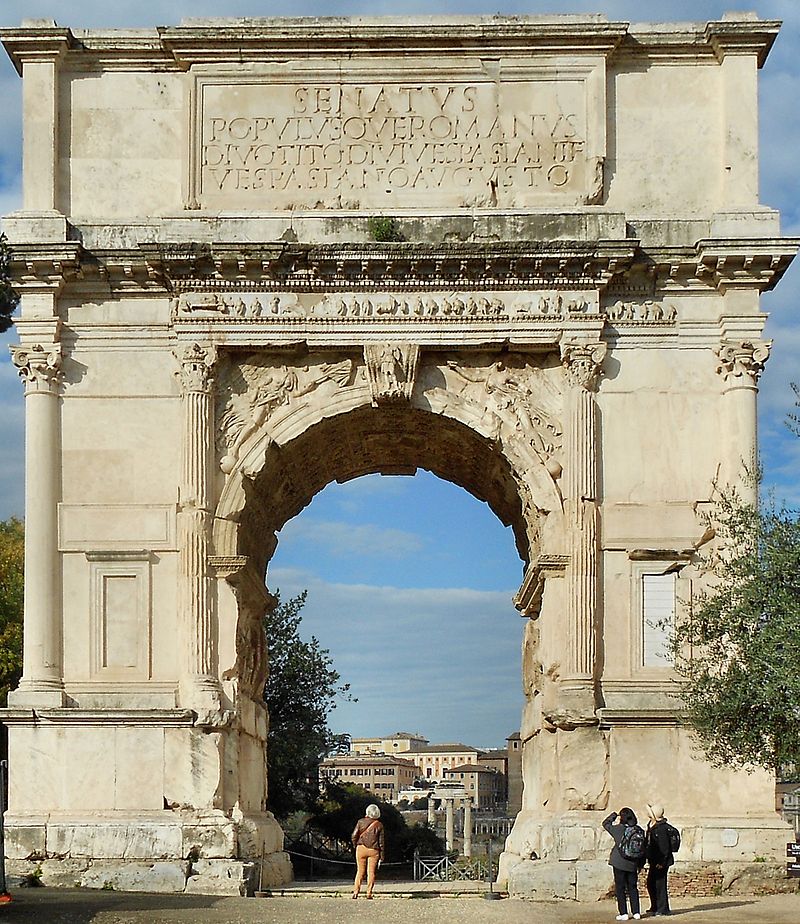I've always been taken with this particular piece which shows the Arch of Titus with the Palatine Hill on the left. It's a reminder both of durability and fragility. The structure, though damaged remains, but the city and Forum surrounding it are mostly long gone, as well as those who built it. The humbleness of the inhabitants we see is also a reminder of the transitory nature of things. The Arch straddles the Sacred Way. Triumphal processions would approach it up a slight incline having just passed by the Colosseum, 300 yards away. Straight in front of them, down another slight incline was the Roman Forum, the heart of the empire.
To the left, the Palatine Hill was crowned by an enormous sprawling complex of Imperial Palaces clad in marble. In 1700 we see the Palatine covered in trees, and scattered people walking through the ruins around the Arch, with a horse walking down the path from the Palatine. The once carefully paved Sacred Way reduced to a rough dirt path. The Arch itself is no longer maintained and is slowly eroding away. The monumental buildings surrounding it long ago had their marble cladding stripped and their exposed cores left to crumble. For more on the deterioration of Classical Rome over the centuries read Belisarius Enters Rome.
The inscription on the Arch reads:
The SenateThe monument was erected by the Emperor Domitian (81-96), the younger brother of the Emperor Titus (79-81), the sons of Emperor Vespasian (69-79), who constituted the Flavian Dynasty. Vespasian, an experienced and stern soldier came to power in the wake of the overthrow and subsequent suicide of Nero (54-68) and amidst the turmoil of the Year of the Four Emperors when it was demonstrated that the legions far from Rome would be the decisive force in choosing the new emperor.
and the People of Rome
to the late revered Titus Vespasian Augustus
son of the late revered Vespasian
As a ruler, Vespasian was strict and personally austere, a complete contrast to the profligate, undisciplined and disliked Nero. Vespasian had his predecessor's hated palace, The Golden House, turn down, filled in its lake and on its former location had the Flavian Amphitheatre (better known to us as the Colosseum) built for the people of Rome. Succeeding him, Titus was more charismatic and popular and his early death due to illness was a shock. The Arch was built shortly after Domitian's accession to the throne. Domitian was also initially popular but sank into paranoia and more and more irrational acts unlike he was assassinated in a conspiracy led by his own wife who feared for her life.
Much of the decorative aspect of the Arch commemorates the accomplishment for which he was most honored by Romans; his crushing of the Jewish Revolt in 67-70 and the sacking and complete destruction of the great temple in Jerusalem. In the photo below the picture you can see a depiction of the great menorah being removed from the temple as a trophy of Rome's victory. When I first saw the Arch in person it created quite a mixture of emotions for me. Thousands of Jews were enslaved by the end of the rebellion and many of them brought to Rome where they worked as part of the labor force constructing the Colosseum. Some may still have been around to work on the Arch of Titus.
Much of the exterior of the Arch a tourist sees today is not the same as that painted by Wittel three hundred years ago. By the early 19th century there had been so much further degradation of the structure that in 1822, at the direction of the Pope, it was completely rebuilt in travertine. The inscription, however, is the original.

The menorah being carried away.

As it looks today:
By Rabax63 (Diskussion) - Own work (Original text: Eigene Aufnahme), CC BY-SA 3.0, https://commons.wikimedia.org/w/index.php?curid=31309658

No comments:
Post a Comment